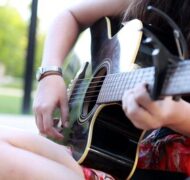Visual and Creative Arts as Ministry: How Art Saves Us
Blog / Produced by The High Calling
Some nights, I can’t sleep. I toss and turn and pray and read and count my sheep. And then, I begin to cry. And when I do, my husband stretches out his hand in the darkness, and I find it and hold it in the loneliness of the dark.
For me, this is what art does.
It reaches out in the middle of the night, and reminds us we are not alone.
Art gives us permission to be human in a way that most humans cannot. Because art doesn't judge. It invites. Art doesn't scorn or ridicule or gossip. Art creates and molds and makes space. Art becomes church for the grunge, for the marginalized and misunderstood, for the druggie and the homeless.
****
We unrolled the long stretch of art paper in the Youth for Christ building—a square brick place beside an old run-down video store— and we gathered there, every two weeks. Me and a gaggle of girls and their sisters, to make art.
I cut pieces of paper, eight by twelve and we squirted bright colors onto the paper. Then, with hands in the acrylic, these teenagers and their broken hearts and their pregnancy scares and their single parent homes, poured out across the pages.
Afterwards, we hung those pictures up to dry. Their stories, turned masterpieces.
This was my job at Chunks—because that was the name we gave the group—to facilitate this kind of ministry. Sometimes we made outfits out of recycled items. Sometimes we sketched with pencils, sometimes it was paint, and one time we threw balloons full of paint at tar paper—the fleshy balls exploding across the black sky like fireworks.
Three years later and I now meet with teenage girls twice a month to teach guitar on the carpet in my living room, my sons on the couch freshly scrubbed in their footy pajamas. We learn chords and talk about anti-depressants. We sing Christian songs and listen to their struggles with cutting. The candle flickers and we eat fuzzy peaches and the boys silently read Winnie the Pooh.
This is the Christian command: to be born again. But no amount of church-going or pious prayers will make us new. To become reborn means first to die to ourselves, and we do this every time we help someone else. Every time we give up an evening to spend with one another, every time we give away our possessions, every time we speak encouraging words to a friend or to a stranger; we are dying to self and entering the process of being reborn.
And art, it is like an umbilical cord attached to that new child. It is the breath of the Holy Spirit, entering us. When we ask Jesus Christ to save us, we’re also asking him to open up the doorway to our true identity, becoming one with a Creator Father. And when I invite teenagers to make art, I am inviting them to touch the heart of God. To discover what it means to be made in his image, all covered in paint and the floor littered in paper and pencil crayons and the walls with bright colored abstracts.
The Holy Spirit is the one who molds, who makes space, who creates. Who listens and doesn’t judge, who invites us to come to Abba as we are—God incarnate in an artist’s workshop.
And this same God reaches out to us in the darkness through his son Jesus, and he holds us. The way art does, the way our husbands do, only with God?
His is a hand will never let us go.
_________________________________________
Visual and Creative Arts as Ministry
This article is part of The High Calling series, Visual and Creative Arts as Ministry. At The High Calling, we believe that art creates a space where people may encounter God, opening a door for transformation. Have you felt it? It’s the way the light ripples across water; it’s the way a good story names something within you; it’s the music you dream in the middle of the night that haunts you in the day. God uses beauty to touch us in the deepest places. As image-bearers of the one true God, we are also co-creators with him, made to impact our culture and each other through the art we bring to life. Does this resonate with you? If so, consider sharing these stories via email, Facebook, Twitter, or through your other social media and friendship networks.
Image by Tim Miller. Used with permission. Sourced via Flickr.





